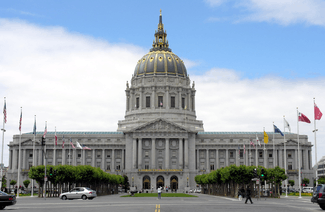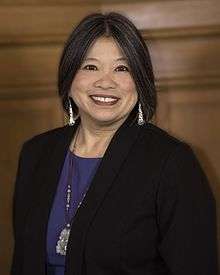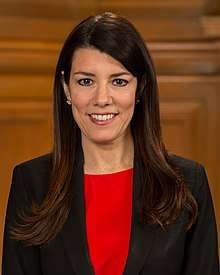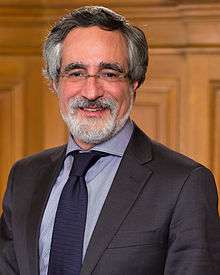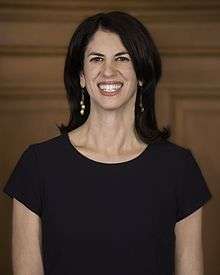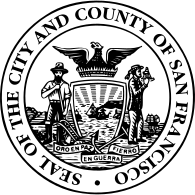Government of San Francisco
The government of the City and County of San Francisco utilizes the "strong mayor" form of mayoral/council government, composed of the Mayor, Board of Supervisors, several elected officers, and numerous other entities. It is the only consolidated city-county in California, and one of only thirteen charter counties of California.[1] The fiscal year 2019–20 city and county budget was approximately $12.3 billion.[2]
Organization
San Francisco utilizes the "strong mayor" form of mayoral/council government, composed of the mayor, Board of Supervisors, several elected officers, and numerous other entities. San Francisco voters use ranked-choice voting to elect the mayor, supervisors, and other elective officers.[3]
Mayor

The Mayor of San Francisco is the head of the executive branch of the city and county government. The mayor has the responsibility to enforce all city laws, administer and coordinate city departments and intergovernmental activities, set forth policies and agendas to the Board of Supervisors, and prepare and submit the city budget at the end of each fiscal year. The mayor has the powers to either approve or veto bills passed by the San Francisco Board of Supervisors, participate in meetings of the Board of Supervisors and its committees, appoint a replacement to fill vacancies in all city elected offices until elections, appoint a member of the Board as acting mayor in his/her absence, and to direct personnel in the case of emergency.[4] The mayor serves a four-year term and is limited to two successive terms.[4] If the mayor dies or resigns, the President of the Board of Supervisors assumes the office as acting mayor. This has occurred twice since the 1970s: Dianne Feinstein became acting mayor after the assassination of George Moscone in 1978, and London Breed became acting mayor following the death of Ed Lee from a heart attack in 2017.
The current mayor as of 2019 is London Breed.
Board of Supervisors
The legislative body is composed of the 11-member Board of Supervisors which acts as both a board of supervisors and a city council, with "[a]ll rights and powers of a City and County which are not vested in another officer or entity" by the charter.[5] The Board of Supervisors is headed by a president and is responsible for passing laws and budgets. The members of the Board of Supervisors are elected as representatives of specific districts within the city.[6]
Catherine Stefani was elected to the position of District 2 supervisor on Jan 30th, 2018, following the appointment of former Sup. Mark Farrell as interim mayor. Malia Cohen was voted in as the President of the Board of Supervisors on June 26, 2018.[7] Vallie Brown was appointed as District 5 supervisor by Mayor London Breed on July 16, 2018.[8]
Other elected officers
In addition, there are other citywide elected officers of San Francisco:[9]
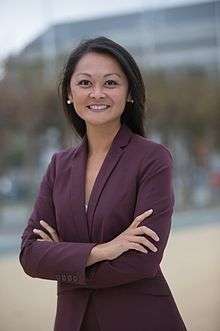 Carmen Chu
Carmen Chu
Assessor-Recorder



 Jose Cisneros
Jose Cisneros
Treasurer and Tax Collector
Departments and agencies
Entities under the authority of the Board of Supervisors include the:[10][11]
- Assessment Appeals Board
- San Francisco County Transportation Authority
- San Francisco Youth Commission
- Clerk of the Board of Supervisors[12]
- Budget and Legislative Analyst
- Office of Legislative Analyst[13]
- San Francisco Local Agency Formation Commission
- Sunshine Ordinance Task Force
Entities under the authority of the San Francisco County Superior Court include the:[10]
- Adult Probation
Entities under the authority of the City Administrator include the:[10]
- Academy of Sciences
- San Francisco International Airport
- San Francisco Arts Commission
- Asian Art Museum
- Office of Economic and Workforce Development
- Department of Emergency Management
- Environment Commission
- Department of the Environment
- General Services Agency
- Animal Care and Control
- Convention Facilities Management
- County Clerk
- Medical Examiner
- San Francisco Department of Public Works
- Purchaser / Office of Contract Administration
- Real Estate Division
- Department of Technology
- Department of Children, Youth and Families
- Civil Service Commission
- Fine Arts Museums
- Fire Commission
- Health Commission
- Department of Public Health
- Human Resources
- San Francisco Human Rights Commission
- Human Services Agency
- Juvenile Probation Commission
- Juvenile Probation Department
- Law Library Board of Trustees
- Office of Transgender Initiatives[14]
- San Francisco Public Library
- San Francisco Municipal Transportation Agency
- Port of San Francisco
- San Francisco Public Utilities Commission
- Residential Rent Board
- Employees' Retirement System
- Recreation and Park Commission
- Commission on the Status of Women
- Department on the Status of Women
- War Memorial
Independent and semi-independent entities include the:[10]
- Board of Appeals
- Building Inspection Commission
- Department of Building Inspection
- Child Support Services
- Controller
- Elections Commission
- Department of Elections
- Entertainment Commission
- San Francisco Ethics Commission
- Health Service System
- Planning Commission
- Planning Department
- San Francisco Police Commission
- San Francisco Police Department
- Office of Citizen Complaints
- Small Business Commission
- Office of Small Business
- Redevelopment Agency
- Treasure Island Development Authority
Other entities and programs include:
- 311 Customer Service Center
A
- Access Appeals Commission
- Animal Control and Welfare Commission
- Asthma Task Force
B
- Back Streets Business Advisory Board
- Ballot Simplification Committee
- Bicycle Advisory Committee
- Biosciences Task Force
- Board of Supervisors
- Budget Analyst's Office
- Building Inspection SRO Task Force, Department of
C
- Citizens' General Obligation Bond Oversight Committee
- City Administrator, Office of
- City Attorney
- City College of San Francisco
- City Hall Preservation Advisory Commission
- Civic Engagement & Immigrant Affairs, Office of
- Civil Grand Jury
- Code Advisory Commission
- Committee On Information Technology
D
E
- Examiners, Board of
F
- Film Commission
G
H
- Historic Preservation Commission
- Housing Authority
I
- Immigrant Rights Commission
J
- Jury Commissioner (Jury Duty)
K
L
- Labor Standards Enforcement, Office of
- Library Citizens Advisory Committee
- Local Homeless Coordinating Board
M
- Marijuana Offenses Oversight Committee
- Medical Cannabis Task Force
N
- Non-Profit Contracting Task Force
O
P
- Power Plant Task Force
- Presidio Neighborhood Representative Work Group
- Presidio & CCSF Transportation Work Group
- Public Finance, Office of
Q
R
- Real Estate Fraud Prosecution Trust Fund Committee
- Redistricting Task Force
- Relocation Appeals Board
S
- San Francisco Fair Lending Working Group
- School District, San Francisco Unified
- SFGovTV - Cable TV (Government Access)
- Shelter Monitoring Committee
- Southeast Community Facility Commission
- State Legislation Committee
T
U
- Unreinforced Masonry Appeals Board
- Utility Undergrounding Task Force
V
- Veterans' Affairs Commission
- Voting Systems Task Force
W
- Western SoMa Citizens Planning Task Force
X
Y
Z
- Zoo, San Francisco
- Zoo Committee, Joint
Finance
Taxes
As of November 2010, San Francisco's sales tax rate was 9.5%,[15] distributed as follows:
- 8.25% - State[16]
- 6.00% - State - General Fund
- 0.25% - State - Fiscal Recovery Fund
- 0.50% - State - Local Revenue Fund
- 0.50% - State - Local Public Safety Fund
- 1.00% - Bradley-Burns Uniform Local Tax Law
- 0.25% - Local County - Transportation funds
- 0.75% - Local City/County - Operational funds
- 0.50% - AB 1077 (1977) Transportation formula - Bay Area Rapid Transit, San Francisco Municipal Railway, AC Transit[17]
- 0.50% - Local/regional transportation
- Proposition B (1989) - 1989-2009: SF County Transportation Authority (60% transit including San Francisco Municipal Railway, 30% street and traffic safety, 8% paratransit, 2% transportation system management).[18]
- Proposition K (2003) - 2009-2034: Different formula for local streets and local and regional public transit.[17]
- 0.25% - San Francisco Unified School District[19]
Budget
The fiscal year 2007-08 city and county budget is as follows:[20]
| Category | Revenue | Ratio |
|---|---|---|
| Charges for services | $1,808 M | 29.7% |
| Property taxes | $1,186 M | 19.5% |
| State | $707 M | 11.6% |
| Other local taxes | $588 M | 9.7% |
| Federal | $360 M | 5.9% |
| Business taxes | $350 M | 5.8% |
| Rents and concessions | $349 M | 5.7% |
| Fund balance from 2006–07 | $239 M | 3.9% |
| Fines and forfeitures | $105 M | 1.7% |
| Interest and investment income | $84 M | 1.4% |
| Licenses, permits, and franchises | $36 M | 0.6% |
| Reserves drawdown | $23 M | 0.4% |
| Other | $244 M | 4.0% |
| Total | $6,079 M | 100% |
| Category | Expenditures | Ratio |
|---|---|---|
| Personnel | $3.083 B | 50.4% |
| Non-personnel operating costs | $1.438 B | 23.7% |
| Debt service | $576 M | 9.5% |
| Capital and equipment | $335 M | 5.5% |
| Grants | $272 M | 4.5% |
| Aid assistance | $271 M | 4.5% |
| Reserves and fund balance | $69 M | 1.1% |
| Facility maintenance | $35 M | 0.6% |
| Total | $6,079 M | 100% |
| Category | Personnel | Ratio |
|---|---|---|
| Public Works, Transportation, and Commerce | 8,798 | 31.5% |
| Public Protection | 6,566 | 23.5% |
| Public Health | 6,196 | 22.2% |
| General Administration and Finance | 2,317 | 8.3% |
| Human Welfare and Neighborhood Development | 2,125 | 7.6% |
| Culture and Recreation | 1,883 | 6.8% |
| Total | 27,885 | 100% |
Municipal Law
The government of the City and County of San Francisco is defined by the Charter of the City and County of San Francisco, which is similar to the other counties of California. Pursuant to its charter, San Francisco causes to be published several codified version of its ordinances and regulations, the San Francisco Municipal Codes. Every act prohibited or declared unlawful, and every failure to perform an act required, by the ordinances are misdemeanor crimes, unless otherwise specified as infractions.[21][22]
San Franciscans also make use of direct ballot initiatives to pass legislation.
San Francisco's municipal authority extends beyond city/county limits through its operation of the San Francisco International Airport and the vast tracts of land supporting the Hetch Hetchy Water System.
Health Commission
The Department of Public Health works through two Divisions of the government - the San Francisco Health Network and Population Health and Prevention. The San Francisco Health Networks includes the health system with locations at multiple hospitals and primary care centers. The Population Health and Prevention Division focuses on the communities in SF and consists of three branches - Community Health and Safety Branch, Community Health Promotion and Prevention Branch, and the Community Health Services Branch.[23] On June 25, 2019, San Francisco become the first major US city to ban Electronic cigarettes.[24]
San Francisco plague of 1900 - 1904
In the 1890s San Francisco received heavy ship traffic from Asian cities that were currently dealing with the bubonic plague. In 1889, a ship from Hong Kong was found to have two cases of bubonic plague on board. The bodies washed up on the bay later, but no immediate outbreak occurred at this initial finding. In 1900 a city health officer autopsied a Chinese man and found evidence of the plague. With anti-Chinese feelings already running rampant throughout the city, the Department of Public Health quickly moved to quarantine Chinatown. Initially the quarantine was protested, not to protect the Chinese, but because of fear and doubt that the plague was indeed in the city. The mayor at the time, James D. Phelan, created the Board of Health, which included multiple doctors on the board. He demanded the Board of Health have 100 physicians search a 12-block area in Chinatown for more cases of the plague. After victims were found, the Board of Health publicly announced the plague, and the Chinatown quarantine was again set into place.[25][26]
Health officials shut down Chinese-owned businesses, and any Chinese or Japanese people attempting to leave the city had to first go through an inoculation with an experimental prophylactic developed by Waldemar Haffkine. This led to a court case between Chinatown resident Wong Wai and the Department of Public Health. Wai won the court case and the Department of Public Health was ordered to stop the inoculations, but city officials got support from the Board of Supervisors to continue.[27] Health authorities also attempted to set up a detention camp for those of Asian descent in Mission Rock, but the idea was protested and canceled, partially due to fear about openly admitting the plague in San Francisco.[26]
Fear of the plague and prejudice against Chinese was so high that many city officials debated burning down Chinatown. The idea popular, especially since this had been done in Honolulu. To prevent their homes from being burnt down and break the quarantine, the Chinese rallied the Chinese Six Companies, multiple attorneys, and China's diplomat. Together, they were ultimately able to get the quarantine lifted again. This was again in part due to the government's fear of publicly confirming plague.[27]
Health authorities from 21 states eventually passed a resolution about California's neglect of duties to address the plague in San Francisco and threatened to close all trade with California. San Francisco businessmen reacted by assembling the Chamber of Commerce, Board of Trade, Merchants’ Association, Marine Hospital Service, new mayor George C. Pardee and various and civil rights groups to clear San Francisco of the plague.[26]
Education
There are several school districts that are co-extensive with San Francisco. The San Francisco Unified School District is governed by the elected seven-member San Francisco Board of Education. The community college district of the City College of San Francisco is governed by an elected seven-member Board of Trustees.
Regional governments
In addition, several regional governmental units in San Francisco operate independently of the municipal government. Five regional agencies—the Association of Bay Area Governments, Metropolitan Transportation Commission, Bay Area Air Quality Management District, San Francisco Bay Regional Water Quality Control Board, and Bay Conservation and Development Commission—have jurisdiction over San Francisco and the other Bay Area counties, and San Francisco appoints representatives to their governing boards.
Several transit agencies provide transit service within San Francisco and adjacent counties, including the Bay Area Rapid Transit (BART), of which residents elect Board of Directors for districts 7, 8, and 9, Golden Gate Transit, Caltrain, the San Francisco Bay Area Water Emergency Transportation Authority, and the Metropolitan Transportation Commission.
State and federal police agencies
Also notable are the independent police forces of the University of California, San Francisco and the Park Police of the Presidio Trust and the Golden Gate National Recreation Area.
Political Parties
Democratic Party
The San Francisco Democratic Central Committee (SFDCC), the governing body of the San Francisco Democratic Party, is a county central committee of the California Democratic Party for San Francisco. The SFDCC is elected from the two Assembly districts in San Francisco and consists of 24 members, with a 14/10 member split between the two Assembly districts based on number of registered Democrats.[28][29]
Republican Party
The San Francisco Republican Executive Committee is the governing party of the San Francisco Republican Party. It is a county committee of the California Republican Party. The Executive Committee are elected every four years by party delegates from two Assembly districts.[30]
Libertarian Party
Every member of the Libertarian Party of San Francisco, the county affiliate of the Libertarian Party of California, is automatically a member of the Central Committee. Four officers are elected from this Central Committee.[31]
Green Party
The San Francisco Green Party, the county affiliate of the Green Party of California, elects a County Council of seven individuals every 2 years.[32]
See also
References
- Baldassare, Mark (1998). When Government Fails: The Orange County Bankruptcy. Public Policy Institute of California/University of California Press. p. 50. ISBN 978-0-520-21486-6. LCCN 97032806.CS1 maint: ref=harv (link)
- "SF Open Book". Retrieved 2020-01-14.
- "Ranked-Choice Voting". City and County of San Francisco, Department of Elections. Archived from the original on August 20, 2009. Retrieved August 8, 2009.
- City and County of San Francisco Municipal Code art. III
- Charter of the City and County of San Francisco, article 1, section 1.101
- "Board of Supervisors District Information". City and County of San Francisco, Board of Supervisors. Archived from the original on July 14, 2007. Retrieved January 29, 2006.
- Fracassa, Dominic (June 26, 2018). "SF supervisors elect Malia Cohen their president as Breed set to become mayor". San Francisco Chronicle. Retrieved July 19, 2018.
- Fracassa, Dominic (July 16, 2018). "SF Mayor London Breed appoints Vallie Brown, former legislative aide, as supervisor". San Francisco Chronicle. Retrieved July 17, 2018.
- Charter of the City and County of San Francisco, article 6, section 6.100
- "City's Organizational Chart". Retrieved 21 June 2018.
- "Board of Supervisors: Divisions". Retrieved 20 May 2014.
- "Clerk of the Board". Retrieved 20 May 2014.
- "Office of the Legislative Analyst". Retrieved 20 May 2014.
- "Office of Transgender Initiatives". City and County of San Francisco. Retrieved June 30, 2019.
- "Archived copy". Archived from the original on 2008-12-17. Retrieved 2008-12-05.CS1 maint: archived copy as title (link)
- "Detailed Description of the Sales and Use Tax Rate - Board of Equalization". Archived from the original on 2008-12-17. Retrieved 2008-12-05.
- "Local Transportation Funding Sources – BayRail Alliance".
- "Archived copy". Archived from the original on 2008-11-14. Retrieved 2008-12-05.CS1 maint: archived copy as title (link)
- "Archived copy". Archived from the original on 2008-11-14. Retrieved 2008-12-05.CS1 maint: archived copy as title (link)
- "Archived copy" (PDF). Archived from the original (PDF) on 2008-11-14. Retrieved 2008-12-05.CS1 maint: archived copy as title (link)
- California Government Code § 25132.
- California Government Code § 36900 et seq.
- "Doing Business with the Department of Public Health". www.sfdph.org. Retrieved 2017-11-22.
- "San Francisco becomes first major U.S. city to ban e-cigarettes — NBC News". apple.news. Retrieved 2019-06-26.
- "A Science Odyssey: People and Discoveries: Bubonic plague hits San Francisco". www.pbs.org. Retrieved 2017-12-08.
- Kalisch, Philip A. (1972). "The Black Death in Chinatown: Plague and Politics in San Francisco 1900-1904". Journal of the Southwest. 14 (2): 113–136. JSTOR 40168068.
- Chang, Iris (2003). The Chinese In America. United States of America: Penguin Group. pp. 139–140. ISBN 978-0-670-03123-8.
- California Elections Code § 7204
- San Francisco Democratic County Central Committee Bylaws, 23 January 2013, Article 2, § 1(a)(1)
- "Meet Your SFGOP". San Francisco Republican Party. Retrieved 2020-08-05.
- "About Us | Libertarian Party of San Francisco". www.lpsf.org. Retrieved 2020-08-05.
- "San Francisco Green Party - About Use".
External links
| Wikimedia Commons has media related to Government of San Francisco. |
- SFGov.org, official site of City and County of San Francisco
- San Francisco Voter Pamphlets and Propositions dating back to 1907 at the San Francisco Public Library
- San Francisco Charter and Municipal Codes from American Legal Publishing
- San Francisco Decoded (unofficial Charter and Municipal Codes) from the OpenGov Foundation
- San Francisco Data
- "San Francisco". U.S. City Open Data Census. UK: Open Knowledge Foundation.
